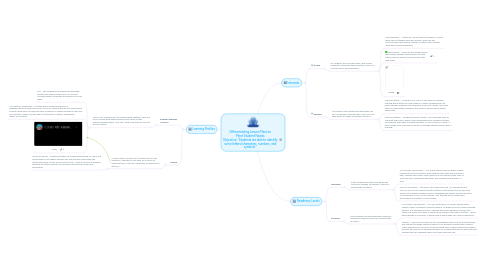
1. Learning Profiles
1.1. English Language Learners
1.1.1. Most of my students are not native English speakers. They are not as familiar with English letters and sounds as their English-speaking peers. How can I make sure they are not lost during lessons?
1.1.1.1. EAL - The “English as an Additional Language” teacher will make sure their pull-out lessons include relevant vocabulary and exposure to unit ideas.
1.1.1.2. 21st Century Technology - YouTube has an amazing selection of language-learning videos and music. Even for children who do not know letters or have a hard time focusing are easily caught up in bright moving pictures and fun melodies. Videos can be used as introductory material, followed by hands-on activities.
1.1.1.3. Video:
1.2. Autism
1.2.1. It seems that a couple of my students fall “on the spectrum,” though it is too early for a doctor to diagnose them. How can I help them to learn best in lessons?
1.2.1.1. Touch & Textures - Looking at letters on a page might boring for some, but having them as 3D shapes children can feel and play with makes the exposure less like “study” and more like “play.” I have a number of different textured 3D letters children can use while we practice sounds and recognition.
2. Interests
2.1. Disney
2.1.1. My students, boys and girls alike, love Disney characters, especially the princesses. How can I use this love in the classroom?
2.1.1.1. Coloring Books -- Thankfully, Disney supports children in more ways than just theme parks and movies. There are also coloring books that expose children to letters and numbers using their favorite characters.
2.1.1.2. Story Books -- There are also Disney books that provide children opportunities to trace letters and find objects in photos that start with them!
2.1.1.3. Image:
2.2. Building
2.2.1. My students love creating anything they can out of materials I provide them. How can I use their desire to design to enhance lessons?
2.2.1.1. Crafting Letters -- Writing is fine, but it is also good for children learning about letters to create them in a larger, tangible form. By giving children materials like cardboard, foam, play-dough, and more, they can make letters, numbers, and symbols during their crafting adventures.
2.2.1.2. Natural Materials -- Bringing children outside, I can challenge them to use what they find to depict their understanding of numbers & letters. For example, they have to create the letter “L” out of leaves, or write “1” with a single stick. This kind of hands-on strategy engages every child in learning.
3. Readiness Levels
3.1. Emerging
3.1.1. Some students are falling just below the classroom average for learning. How can I differentiate for them?
3.1.1.1. 21st Century Technology -- Our school tablets have a variety of apps installed to promote literacy. With both the app audio and a teacher’s help, children who need a little catching up can practice their skills at their own pace, going through letters and numbers during their ICT time.
3.1.1.2. One-on-one praise -- Because of my small class size, it is possible to get one-on-one time to support student learning. Getting that one-on-one time allows me to pinpoint where a child is struggling and design specific activities to support him or her, not to mention I can take the time to praise and encourage any progress in our sessions.
3.2. Excelling
3.2.1. Some students are exceeding the classroom average for learning. How can I differentiate for them?
3.2.1.1. 21st Century Technology -- As I just mentioned, our school tablets have a variety of apps installed to promote literacy. It’s great not only to help emerging learners, but excelling ones too. Children who have mastered numbers and letters can move on to apps in which those symbols are used in context-- such a being applied to counting, or being used in words they can match meanings to.
3.2.1.2. Mentors -- The young students in my Kindergarten really look up to (figuratively and literally) the grade school students in our building. Having older students come downstairs on occasion to demonstrate skills or help students build theirs will give the chance for excelling students to converse with and do activities with children who will challenge them more than their peers do.
